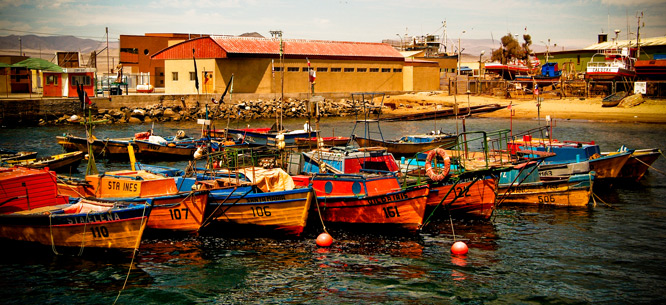The Ballad of Chile’s Last Outlaw Fishermen
The Ballad of Chile’s Last Outlaw Fishermen

On clear days, you can see dozens of ships from Chile’s artisanal fleet fishing the cool waters of the country’s southern coast, their nets extended across rings of yellow buoys. It can take a half-dozen nets full of fish to top up the ships’ fifty-ton holds. For the men of the ships—who work whenever there is light and wherever they find fish—this means days of hauling line, stacking and repairing nets, and siphoning fish into the hold.
But the gatos can simply steal it.
The Jesse James of southern Chile, the gato—“cat” if your sixth-grade Spanish is rusty—developed alongside Chile’s fishing industry. From poor fisherman to professional criminal, gatos became a scourge of commercial fishing companies, which have dominated the business over the last three decades. They became capable of seizing ships on the high seas and stealing tons of fish—mostly the metallic-blue jack mackerel or the toothy hake—from industrial trawlers before spiriting their loaded skiffs back to fishing towns and villages along the coast.
“They ask the industrial crews to ‘gift’ them some fish,” explained Marta Espinoza, director of a fishermen’s guild in Coronel, when I visited the southern city last June. Regardless, she said, the fish “belong to us.”
Before gatos began stealing fish during the industry’s peak in the 1980s, a few fishermen started taking boats out from small artisanal ports to the commercial boats to beg for fish. The fishermen and industrial crews often came from the same village or had worked aboard the same boat at some point in their lives, according to Espinoza. Taking pity—or a cut of the profits—the crew would pass on a small load of fish to the expectant fishermen, who would then sell it back on land.
Back then, there was no official difference between artisanal and industrial fishermen, but most of the small-scale fishing was done by hand, while larger companies could afford to invest in advanced technology like deep-sea trawling. The adoption of the General Law of Fisheries and Aquaculture in 1989 drew a clear legal line between the two sectors. Among other restrictions, the Pinochet-era law carved up access rights to the oceans, allotting the first five miles off shore for artisanal fishing vessels—boats under sixty feet—and leaving the rest of the country’s 200-mile exclusive economic zone open for commercial exploitation.
Ships began scooping out the oceans at a rising clip. Expanding fleets and the lure of new markets drove the development of new fisheries. The first fishery for Patagonian toothfish—known in the United States as Chilean sea bass—opened in 1992, followed by orange roughy in 1997. The industry also began focusing on fishmeal and fish oil production, following a trend that began in the 1980s. Both products require massive amounts of biomass, and landing rates for anchovy, sardine, and jack mackerel balloo...
Subscribe now to read the full article
Online OnlyFor just $19.95 a year, get access to new issues and decades' worth of archives on our site.
|
Print + OnlineFor $35 a year, get new issues delivered to your door and access to our full online archives.
|




